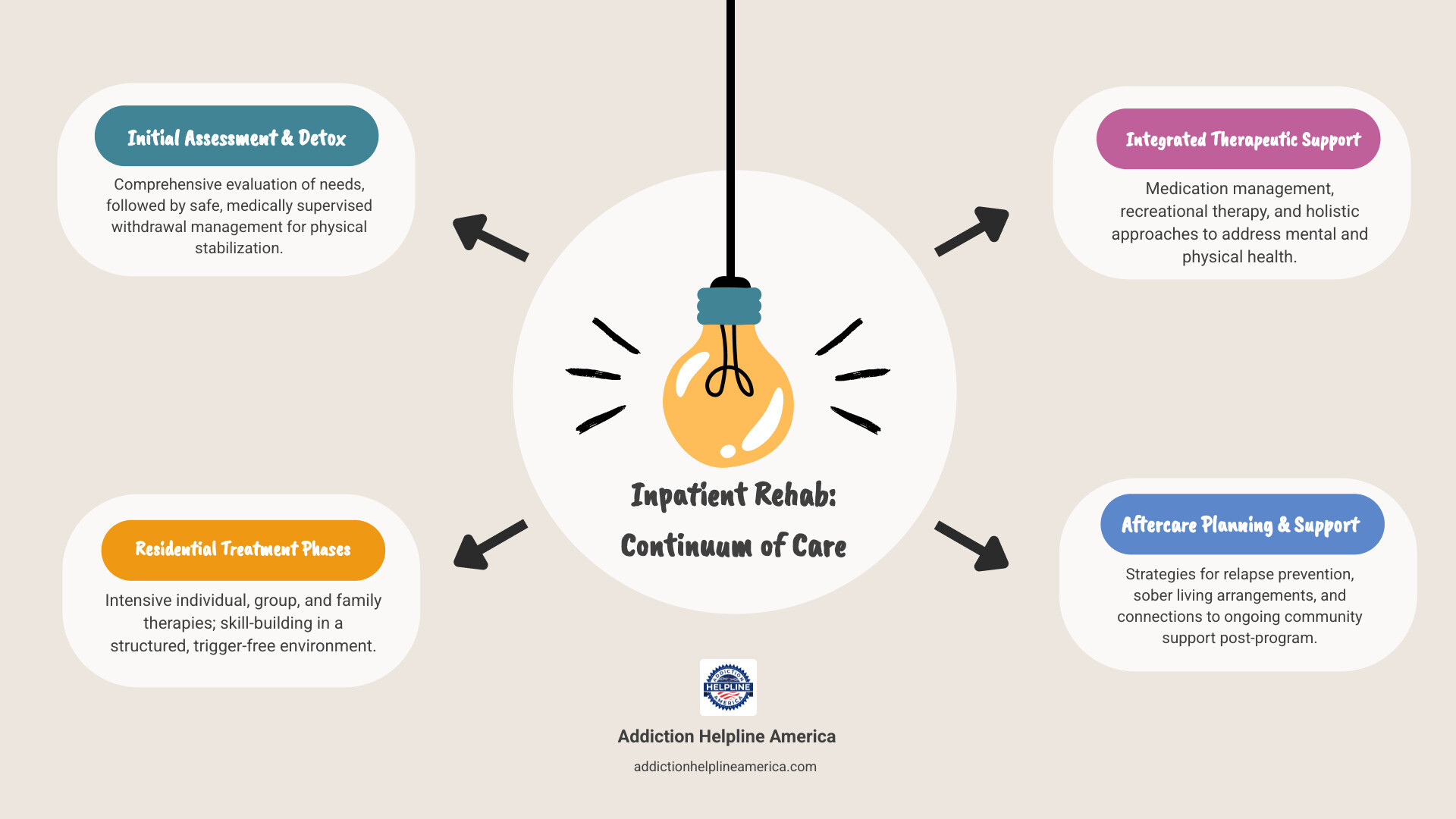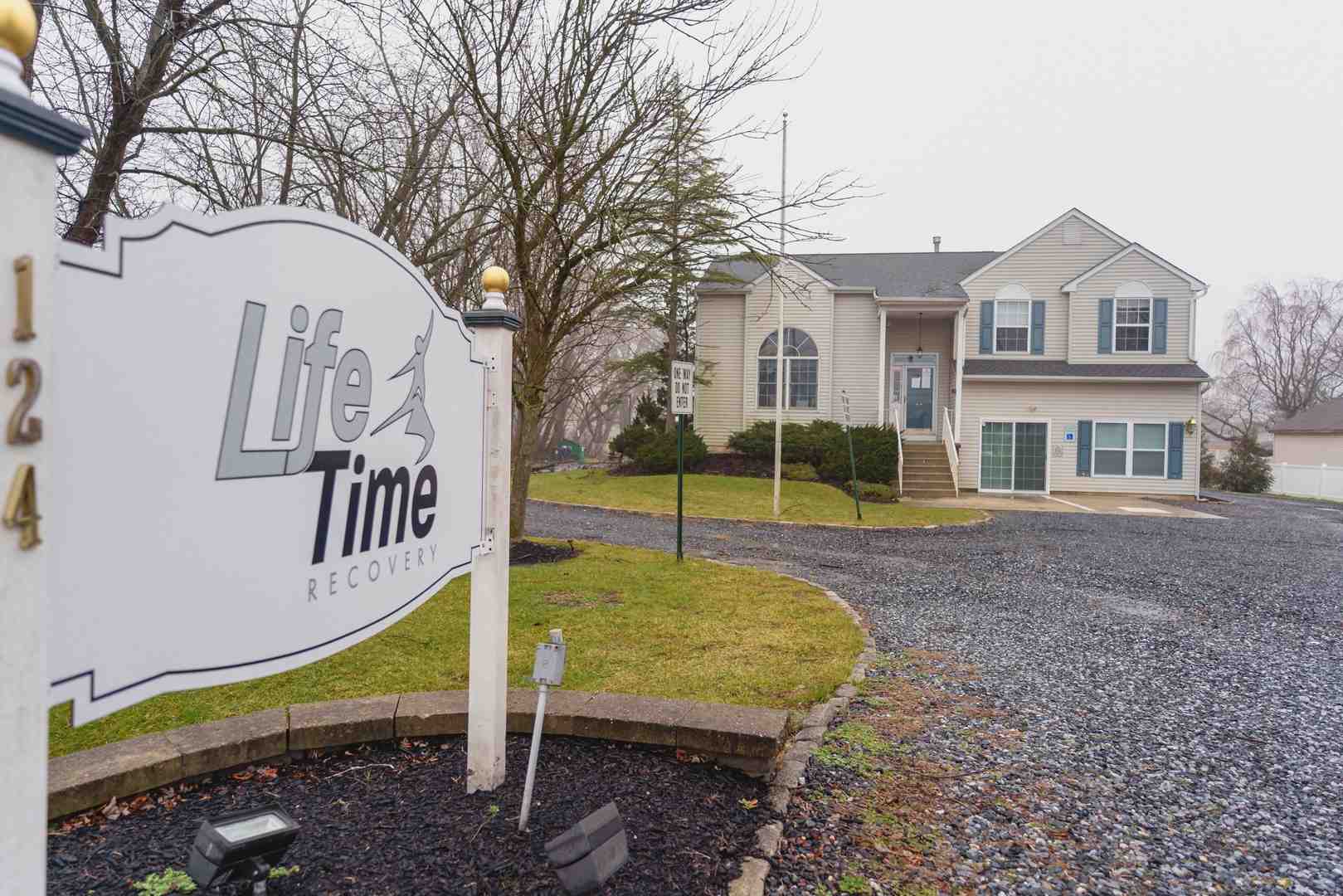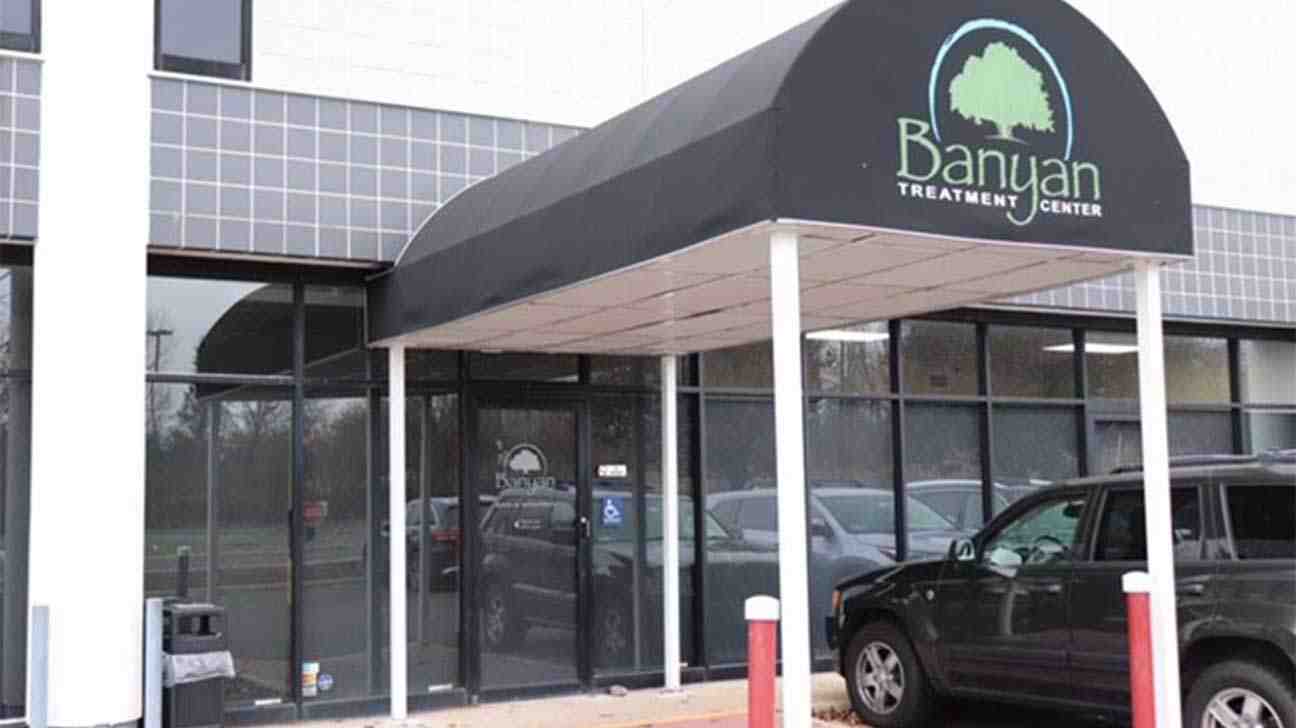
Why Finding the Right Inpatient Rehab Program Can Save Your Life
Inpatient rehab programs offer the most intensive addiction treatment available, providing 24/7 medical supervision and structured support in a residential setting. Lasting 30-90 days, these programs combine several key components to address severe substance use disorders:
- 24/7 Medical Supervision – Round-the-clock care from doctors and addiction specialists.
- Structured Environment – A safe, trigger-free setting focused entirely on recovery.
- Comprehensive Treatment – A mix of individual, group, and family therapy.
- Medical Detox – Medically supervised withdrawal management when necessary.
- Dual Diagnosis Care – Integrated treatment for co-occurring mental health conditions.
- Aftercare Planning – Transition support, including sober living and ongoing therapy options.
Research shows that longer treatment durations lead to better outcomes, with many participants reporting low or no cravings one year after treatment. The decision to enter an inpatient rehab program can be life-changing, leading to vast improvements in health and personal life.
At Addiction Helpline America, we’ve helped thousands find programs that match their unique needs. We understand that the right program can be the difference between lasting recovery and continued struggle.

Understanding Inpatient Rehab and Its Benefits
Deciding to seek help for addiction takes courage. When you’re ready, it’s crucial to understand your options. Inpatient rehab programs offer one of the most effective paths to recovery.
What is Inpatient Treatment?
Also known as residential treatment, inpatient treatment means you live at a specialized facility while receiving intensive, 24/7 care for addiction. Unlike outpatient programs, inpatient care creates an immersive healing environment where recovery is your full-time focus. You are surrounded by medical professionals, therapists, and trained staff who are always available to provide support, which is invaluable during difficult moments or cravings.
This table highlights the key differences between inpatient and outpatient care:
| Feature | Inpatient Rehab | Outpatient Treatment |
|---|---|---|
| Structure | Highly structured daily schedule with fixed routines | Flexible schedule that allows you to continue daily life |
| Intensity | Full-time engagement in therapy and recovery activities | Part-time sessions that fit around other commitments |
| Environment | Live-in facility, completely removed from triggers | Live at home while facing daily triggers and responsibilities |
| Supervision | Round-the-clock medical and clinical oversight | Scheduled sessions with clinical oversight |
| Ideal Candidate | Severe addiction, co-occurring disorders, unstable home environment, history of relapse | Mild to moderate addiction, stable home life, strong support system, work or school commitments |
This structured, intensive approach creates a “protective bubble” where you can focus entirely on healing without the stress of daily life, family issues, or the temptation of old triggers.
Key Benefits of an Inpatient Setting
Choosing an inpatient program offers several life-saving advantages that build a strong foundation for sobriety.

- 24/7 Medical Supervision: Constant access to doctors and nurses is critical, especially during medical detox when withdrawal can be dangerous. The team monitors your health, manages symptoms, and ensures your safety.
- Safe and Structured Environment: Inpatient rehab programs remove you from the chaos of active addiction. A predictable schedule helps rebuild healthy routines and allows your brain to rest and heal.
- Freedom from External Triggers: By removing you from people, places, and situations that trigger cravings, inpatient care provides the space needed to build new coping skills without constant temptation.
- Peer Support and Community: Living alongside others on a similar journey creates powerful bonds. Sharing experiences in group therapy and daily activities reminds you that you are not alone in your struggle.
- Focus Solely on Recovery: Without the distractions of work or family obligations, you can immerse yourself completely in the healing process, maximizing the effectiveness of your treatment.
Signs You Might Need an Inpatient Program
Certain signs indicate that the comprehensive support of an inpatient rehab program is the most appropriate choice:
- Severe Substance Use Disorder: If substance use is chronic, compulsive, and causing major life problems, the structure of inpatient care may be necessary to break the cycle.
- Co-occurring Mental Health Conditions: If you struggle with depression, anxiety, or PTSD alongside addiction (dual diagnosis), an integrated inpatient program can treat both conditions simultaneously for the best outcome.
- Unsupportive Home Environment: If your living situation lacks sober support or is filled with triggers, inpatient treatment provides a necessary safe haven.
- History of Relapse: If you’ve tried less intensive programs without success, the 24/7 structure of inpatient care can provide the support needed for a fresh start.
- Medical Complications: If you are at risk for dangerous withdrawal symptoms or have other health issues related to substance use, inpatient medical supervision is essential.
Choosing inpatient treatment is a sign of strength—recognizing you deserve the level of care that gives you the best chance at recovery. We’re here to help you make that choice.
Choosing the Right Inpatient Rehab Program: A 5-Step Guide
Finding the right inpatient rehab program is a critical decision. This five-step guide will help you steer the process and choose the program that best fits your needs.
1. Assess Your Clinical and Personal Needs
Before you begin your search, take an honest look at your situation. Effective treatment must be custom to your specific circumstances.
- Substance of Abuse: Different substances require different treatment approaches. Alcohol withdrawal, for instance, is treated differently than opioid withdrawal.
- Medical and Mental Health: Your overall health is a key factor. Chronic health conditions or a co-occurring mental health disorder like depression, anxiety, or PTSD (a “dual diagnosis”) require a program equipped to provide integrated care.
- Need for Medical Detox: Withdrawal from substances like alcohol, opioids, or benzodiazepines can be dangerous. If you need detox, ensure the program offers medical supervision.
- Specialized Programs: Consider if a specialized program would be beneficial. Options include gender-specific, age-specific (for adolescents or older adults), or programs for veterans.
2. Evaluate the Program’s Treatment Approach and Therapies
Once you know what you need, investigate how different programs provide treatment. Look for facilities that use proven, evidence-based approaches.
- Evidence-Based Therapies: Quality inpatient rehab programs use therapies backed by research. Common examples include Cognitive Behavioral Therapy (CBT), which helps change negative thought patterns, and Dialectical Behavior Therapy (DBT), which is effective for intense emotions and trauma.
- Family Therapy: Addiction impacts the entire family. Programs that include family therapy help heal relationships and teach your loved ones how to support your recovery.
- Holistic Therapies: Activities like yoga, art therapy, and meditation can complement traditional therapy, helping you manage stress and process emotions in new ways.
- Medication-Assisted Treatment (MAT): For opioid and alcohol addiction, FDA-approved medications can reduce cravings and withdrawal symptoms, supporting your recovery while you engage in therapy.
3. Verify Facility Credentials and Staff Qualifications
Ensure the program you choose is reputable and staffed by qualified professionals. Don’t hesitate to ask for proof of their credentials.
- Accreditation: Look for accreditation from organizations like The Joint Commission or CARF (Commission on Accreditation of Rehabilitation Facilities). This indicates the facility meets high standards for patient care and safety.
- State Licensing: Every legitimate facility must be licensed by the state in which it operates.
- Staff Qualifications: The clinical team should include medical doctors, licensed therapists, and certified addiction counselors with experience in treating substance use disorders.
- Staff-to-Patient Ratio: A lower ratio generally means more personalized attention. Ask about this when you inquire.
4. Consider Program Duration and Aftercare Planning
Recovery is a long-term process. The length of your stay and the support you receive afterward are crucial for success.
- Program Duration: While 30-day programs are common, research shows that longer stays (90 days or more) lead to significantly better long-term outcomes. The right length depends on your individual needs and progress.
- Aftercare Planning: A good program begins planning for your transition home from day one. This plan is your roadmap for maintaining sobriety after you leave.
- Relapse Prevention: You’ll learn to identify personal triggers, develop healthy coping skills, and create a plan for what to do if cravings occur.
- Ongoing Support: Aftercare often includes connections to sober living homes, support groups like AA or NA, and continued individual or group therapy to help you maintain your progress.
5. Determine Costs and Verify Insurance Coverage
While cost is a valid concern, don’t let it prevent you from seeking help. Many options are available to make treatment affordable.
- Treatment Costs: Costs vary based on the facility, services, and length of stay. Standard inpatient rehab programs can range from $200-$500 per day, while luxury options cost more.
- Insurance Coverage: Most health insurance plans cover substance abuse treatment. Call your provider to understand your specific benefits, including deductibles and co-pays.
- In-Network vs. Out-of-Network: Choosing an in-network facility will significantly reduce your out-of-pocket costs.
- Other Financial Options: If insurance is limited, ask about payment plans, sliding scale fees based on income, or financing. Organizations like the Substance Abuse and Mental Health Services Administration (SAMHSA) offer free guidance. Their National Helpline (1-800-662-HELP) can provide treatment referrals and information on financial assistance.
At Addiction Helpline America, we help you find programs that fit your treatment needs and your budget. Recovery is possible regardless of your financial situation.
What to Expect: From Admission to Aftercare
Knowing what to expect can make the first step into an inpatient rehab program feel less intimidating. Here’s a walkthrough of the process, from your first call to long-term recovery support.
The Role of Medical Detox in Inpatient Rehab Programs
If you have been using substances regularly, your body may be physically dependent on them. Stopping use can lead to withdrawal, a process that can be uncomfortable and sometimes dangerous. Medical detox provides a safe, supervised environment for this crucial first phase of recovery.
- Managing Withdrawal: The primary goal of detox is to manage withdrawal symptoms safely and comfortably. A medical team uses proven medications and supportive care to ease discomfort.
- 24/7 Medical Monitoring: Nurses and doctors monitor your vital signs and overall health around the clock, ready to intervene if complications arise. You are never alone during this vulnerable time.
- Essential for Certain Substances: For substances like alcohol, opioids (heroin, painkillers), and benzodiazepines (Xanax, Valium), medically supervised detox is essential due to the risk of life-threatening withdrawal symptoms.
As SAMHSA’s guidelines emphasize, detox involves evaluation, stabilization, and preparing you for the transition into therapy. By managing the physical aspects of withdrawal first, you can fully engage in the psychological work of recovery.
The Admissions Process Explained
The admissions process is designed to be as supportive and straightforward as possible.
- Confidential Phone Assessment: Your journey begins with a call to a recovery expert. You’ll discuss your substance use history, medical needs, and mental health concerns. This confidential, non-judgmental conversation helps determine if an inpatient rehab program is the right fit.
- Insurance Verification: The admissions team will help verify your insurance benefits early on, explaining your coverage and any out-of-pocket costs so you have financial clarity.
- Pre-admission Screening: A more detailed screening may be required to ensure the facility’s services align with your needs and to create a personalized treatment plan.
- Travel and Logistics: The facility will provide guidance on travel arrangements and may help coordinate transportation if needed.
- What to Pack: You’ll receive a list of what to bring (comfortable clothes, toiletries) and what to leave at home (prohibited items like non-prescribed substances or weapons).
- Arrival and Orientation: On your first day, you’ll have a medical check-up, complete paperwork, and get a tour of the facility. This is your chance to meet staff and fellow residents and settle into your new, supportive environment.
Frequently Asked Questions about Inpatient Rehab Programs
It’s natural to have questions when considering an inpatient rehab program. Here are answers to some of the most common ones we hear.
How long does inpatient rehab usually last?
The length of stay is custom to your individual needs. While 30 days is a common starting point, programs often range from 28 to 90 days. Research consistently shows that longer stays—particularly 90 days or more—significantly improve long-term recovery outcomes. For those with severe addiction or complex needs, long-term programs of 6-12 months are also available. Your treatment team will recommend the appropriate duration based on your clinical progress.
Can my family be involved in my treatment?
Yes, and it’s highly encouraged. Addiction affects the entire family, so quality inpatient rehab programs make family involvement a priority.
- Family Therapy: These sessions provide a safe space to rebuild trust, improve communication, and heal relationships.
- Educational Programs: Workshops teach your loved ones about the disease of addiction and how to support your recovery in healthy ways.
- Healthy Boundaries: Therapy helps the family learn to set healthy boundaries, which is essential for everyone’s well-being and your long-term success.
Family involvement can significantly strengthen your recovery, and most programs welcome and facilitate their participation.
What happens after I complete an inpatient program?
Graduating from an inpatient program is the beginning of your lifelong recovery journey. A strong aftercare plan is essential for a successful transition back to daily life.
- Personalized Aftercare Plan: During your stay, you and your treatment team will create a detailed roadmap for maintaining sobriety, which may include step-down care, sober living, and ongoing therapy.
- Step-Down Care: Many people transition from inpatient care to less intensive options, like a Partial Hospitalization Program (PHP) or an Intensive Outpatient Program (IOP), for continued support.
- Sober Living Homes: These structured, substance-free residences offer peer support and accountability as you readjust to work, school, and daily responsibilities.
- Support Groups: Communities like Alcoholics Anonymous (AA), Narcotics Anonymous (NA), or SMART Recovery provide ongoing encouragement and a network of peers who understand your journey.
- Ongoing Therapy: Continuing with individual or group therapy helps you steer challenges and reinforce the coping skills you learned in treatment.
Aftercare provides the tools and support system you need to build a fulfilling, substance-free life.
Take the First Step Towards Recovery Today
Finding the right inpatient rehab program is a critical step toward a new life. These programs offer a unique combination of 24/7 medical supervision, a trigger-free structured environment, and the powerful support of peers who understand your struggle. By following the steps to assess your needs, evaluate programs, and plan for the future, you can find the right fit.
Recovery is a journey, and it begins with the decision to choose hope. We know this decision can be daunting, with concerns about cost, family, or work. These feelings are normal, but they don’t have to be barriers.
At Addiction Helpline America, our mission is to make the path to recovery clear and accessible. We provide free, confidential, and personalized guidance, connecting you to a trusted network of treatment centers. Our team listens to your unique story to find a program that empowers you to build the healthy, substance-free life you deserve.
Don’t let the complexities of finding treatment stand in your way. We’re here to help, just a phone call away.
Your new chapter starts now. Let us help you take the first step.
Our helpline is 100%
free & confidential
If you or someone you care about is struggling with drug or alcohol addiction, we can help you explore your recovery options. Don’t face this challenge alone—seek support from us.
Programs
Resources
Will my insurance
cover addiction
treatment?
We're ready to help
Find the best
drug or alcohol treatment
center
Are you or a loved one struggling with addiction? Call today to speak to a treatment expert.














